Click Here to Take Action on Striped Bass & More…
Background & Timeline
The Coastal Conservation Association’s (CCA) Angler’s Guide to Amendment 7 has been updated to reflect the changes made by the Striped Bass Management Board (Board) of the Atlantic States Marine Fisheries Commission (ASMFC) since May 2021.
On January 26, 2022 the Board approved for public comment Draft Amendment 7, which is now open and runs through April 15, 2022. Once the public comment period ends, ASMFC staff will provide to the Board the public comments and further information for consideration at the Board’s May 2022 meeting, where the Board is expected to approve the final version of Amendment 7. It will then become the new management plan for striped bass coast wide for the foreseeable future.
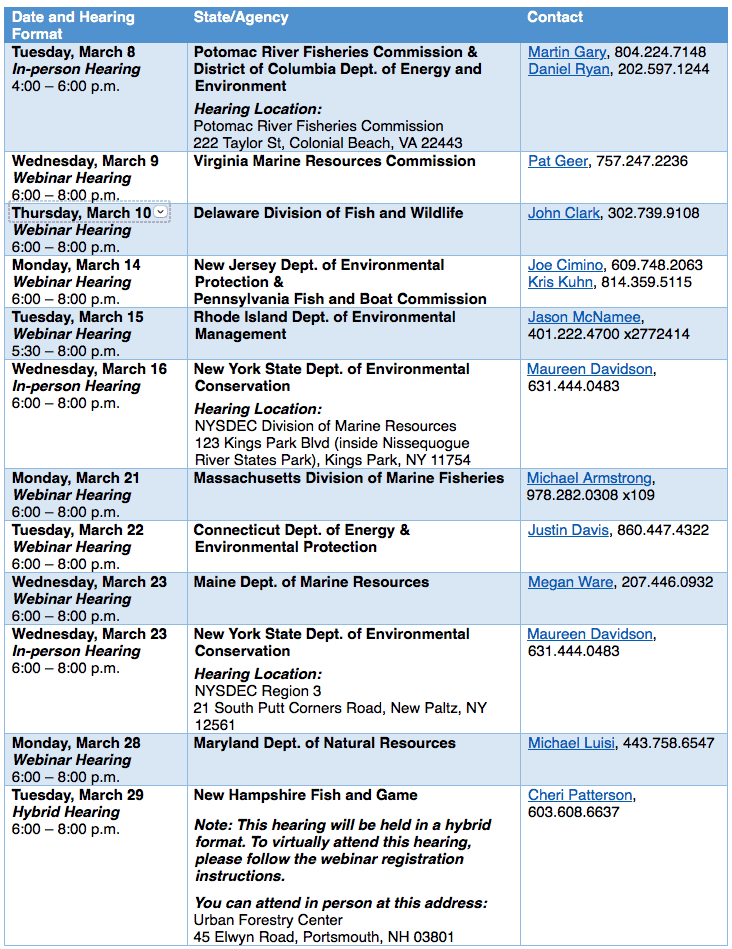 Public Comment
Public Comment
Specifics vary for each state (see table). Details for each state’s public meeting and webinar log in information is available on ASMFC’s website.
A Youtube video may be viewed for the full ASMFC staff presentation on this draft amendment.
A Look Ahead for On-the-Water Changes
For many anglers concerned about rebuilding the striper population, one question commonly asked is: When should we expect to see changes in fishing regulations? Changes to Maryland and other state regulations that affect creel and season will likely be implemented in time for the 2023 fishing season.
That said, all eyes should be on October 2022. That is when the most recent striped bass stock assessment is scheduled for release. This update will give us the first science-based look at the outcomes of the last reduction in fishing mortality, implemented through Addendum VI in 2019.
During the January 2022 Board meeting, the following motion was passed by consent, adding an option to fast track the implementation of measures that will lower fishing mortality in section 4.4 Rebuilding plan. This action is open for public comment, and would likely lead to consistent regulations on the Atlantic coast and consistent regulations in the Chesapeake Bay if the stock assessment results require action per this motion:
Move to add an option to Section 4.4: Rebuilding Plan that considers an alternative process for responding to the 2022 stock assessment, as follows: If the 2022 stock assessment results indicate the Amendment 7 measures have less than a 50% probability of rebuilding the stock by 2029 (as calculated using the recruitment assumption specified in Amendment 7) and if the stock assessment indicates at least a 5% reduction in removals is needed to achieve F rebuild, the Board may adjust measures to achieve F rebuild via Board action.
Keep in mind that fishing mortality rate (F) is the metric that fishery managers use to control removals from the stock. The fishing mortality target, or in this case, the F rebuild is a level set to achieve rebuilding by 2029. If this F rate changes, it will determine the regulations on the water.
Also this fall, the results of the 2022 Young-of the-Year (YOY), also called Juvenile Abundance Index (JAI), from Chesapeake Bay and other major spawning areas will be released. These indices are a crucial indicator of future striper health and sustainability.
The Board is seeking input on the motion above in Section 4.4 Rebuilding Plan. Further information regarding this is listed in the appropriate section of this guide.
Navigating the Draft Amendment 7 Document
The Draft Amendment 7 document includes valuable information about the Atlantic striped bass fishery. It is also long and complicated. Although CCA Maryland recommends that you review this information, the most important components of the document are those in which the Board is seeking your input on numerous options.
Section 4.0 Management Program and Proposed Options can be found on page 44 of the document, or page 52 of the online PDF.
The following sections are what CCA believes the public should focus the majority of their feedback on during this public comment period. Also, a summary of public comment will be compiled by ASMFC staff and presented to the Board at their May meeting.
The specific pages where this information can be found are listed next to the title in both document page numbers (ie: page number on paper) and online PDF pages XX of 149.
Draft Amendment 7 Components
4.1 Management Triggers (pg. 44 of doc. pg. 52 of 149 of PDF)
In Draft Amendment 7 there are multiple tiers of triggers that relate to varying topics. Each Tier has subsequent options and sub-options, which affect these actions and outcomes. Figures 2a, 2b and 2c starting on page 55 of the doc. and pg. 63 of 149 provide a visual guide that you may find easier to follow.
CCA Recommendations: Management Triggers are a great precautionary concept, but often difficult to execute. The data generally used for such triggers can be highly variable (F, SSB and recruitment levels). The main goal of a management trigger is to recognize a decline in abundance and trigger corrective management action. Simply put, do not allow the current decline in abundance to happen again. The control of fishing morality, F is paramount to rebuilding the striped bass resource and maintaining higher levels of abundance in future years. To achieve these overall goals of the striped bass FMP, some triggers may be more effective than others, but what is most important is that the Board takes action when triggers are tripped and pro-actively reduces F when recruitment falters and removals affect the SSB status.
***The CCA prefered options are as follows***:
Tier 1: Fishing Mortality (F) Management Triggers
Sub-option A1 (status quo): Reduce F to a level that is at or below the target within 1 year
Sub-option B1: (status quo): If F exceeds the F threshold, the striped bass management program must be adjusted to reduce F to a level that is at or below the target within the timeframe selected under Option A
Sub-option C1 (status quo): If F exceeds the F target for two consecutive years and female SSB falls below the SSB target in either of those years, the striped bass management program must be adjusted to reduce F to a level that is at or below the target within the timeframe selected under sub-option A.
Tier 2: Female Spawning Stock Biomass (SSB) Management Triggers
Sub-option A2: Two-Year Deadline to Implement a Rebuilding Plan. The Board must implement a rebuilding plan within two years from when an SSB-based management trigger is tripped. A management trigger is not considered tripped until the Board formally reviews and accepts, if necessary, the results of the relevant stock assessment.
Sub-option B1: If female SSB falls below the SSB threshold, the striped bass management program must be adjusted to rebuild the biomass to the target level within an established timeframe [not to exceed 10-years].
Sub-option C3 : No management trigger related to the female SSB target. Increasing SSB is a vital goal that is largely driven by recruitment and rebuilding efforts related to the control of F. CCA supports aggressively controlling F and the Board being proactive to return and maintain SSB above the threshold and to the target while focusing on keeping F well below the threshold and at the target during all management periods.
Tier 3: Recruitment Triggers
Sub-option A2: The recruitment trigger is tripped when any of the four JAIs used in the stock assessment model to estimate recruitment (NY, NJ, MD, VA) 11 shows an index value that is below 75% of all values (i.e., below the 25th percentile) in the respective JAI from 1992-2006, which represents a period of high recruitment, for three consecutive years. The high recruitment reference period used for this trigger may be adjusted as recommended by the TC during benchmark stock assessments. This trigger alternative has a moderate sensitivity; it is more sensitive than the status quo but less sensitive than sub-option A3 (Figure 1). This trigger alternative would have tripped three times since 2003: NY in 2006; MD in 2010; MD in 2014 (Table 2).
Sub-option B2: If the recruitment trigger is tripped, an interim F target calculated using the low recruitment assumption is implemented, and if F from the terminal year of the most recent stock assessment is above the interim F target, the striped bass management program must be adjusted to reduce F to the interim F target within one year.
Tier 4: Deferred Management Action
Option A (status quo): No Deferred Management Action. If any (or all) of the management triggers are tripped following a benchmark stock assessment or assessment update, the Board is required to respond to that trigger regardless of when the last management action was implemented in response to any management trigger
Option F: If a management trigger trips after the Board has already initiated action in response to a different management trigger, the Board can defer management action in response to the subsequent trigger until the next assessment.
CCA Comments: In the simplest terms, Option A is the best trigger approach for timely and reactive management for the striped bass fishery at this time. Option F is also an important concept to consider given recent history and the technical process which is used to set regulations each year or for multiple years. If Option F is considered in a practical application that may be facing the Board in future years it may be a valuable tool to maintain stability, another important goal of many recreational fishery management plans. It will also allow management to be lead by updated stock assessments every 2-3 in striped bass fishery. Overall, management action should not be deferred when clear and logical actions should be taken by the Board to maintain rebuilding timelines in any recreational fishery. This issue has been front of mind for many anglers and the Board should show that they understand the importance of pro-active conservation based actions when long lived fish species like striped bass are undergoing overfishing and facing uncertainty in recruitment success as they are at this time.
4.2 Recreational Fishery Management Measures (pg. 56 of doc. pg. 64 of 149 of PDF)
4.2.1 Size Limits, Bag Limit & Seasons
Size limits are used to determine what fish are exploited relative to how fishing mortality is applied across the estimated populations of striped bass coast wide.
The current baseline regulations of one fish @ 28″ to <35″ for the Atlantic ocean fishery and one fish @ 18″+ for the Chesapeake Bay fisheries and seasons that were in place in 2017, are stated as the measures in place under the current management plan. These measures will remain in place until future Board action, which may occur this October pending the results of the next stock assessment update.
This is inconsistent with current Maryland regulations adopted under conservation equivalency through Addendum VI. This difference is described on page 56 of the PDF document or pg. 64 of 149 online in this footnote:
Some states have implemented alternative recreational size limits, bag limits, and seasons through conservation equivalency, which are maintained through current (approved in 2020) CE programs and state implementation plans from Addendum VI to Amendment 6. See Table 10 in Section 9.0 for each state’s 2020 recreational measures. Maryland’s updated summer no-targeting closure dates (changed from August 16-31 closure in 2020 to July 16-31 closure in 2021) was discussed at the August 2021 Board meeting
The final option selected by the board in section 4.2.2 Option B, may affect the existing two week mid-season closure in Maryland. (See document page 62 or PDF page 70 of 149)
4.2.2 Measures to Address Recreational Release Mortality (pg. 67 of doc. pg. 75 of 149 of PDF)
Catching and releasing fish is a major part of all fishing, no matter the regulations or the fishery. Until anglers can truly pick the fish that bites their hook and only the fish they want to keep, release mortality will also be a part of fishing. Some anglers choose to release all of the fish they catch while others choose to keep a limit and turn their attention to other species. The possibilities in the recreational fishing world in this regard are truly endless.
The following options are included in Draft Amendment 7:
Option A: (status quo), Addendum VI circle hook measures – **CCA Preferred Option**
Option B: Effort Controls (Seasonal Closures)
B1: State Specific Two-Week Closures
B2: Spawning Area Closures
B2-a: No Harvest Spawning Closure Required January-April:**CCA Preferred Option**
B2-b: No Targeting Spawning Closure
Option C: Additional Gear Restrictions: – ** No CCA Preferred Coastwide Option**
C1: Prohibit use of lethal devices to remove striped bass from the water (ie: gaffs)
C2: Require release of striped bass caught on unapproved gear (ie: J hook w/ bait)
Option D: Outreach & Education
D1: Require states to develop public outreach & education campaigns: – **CCA Preferred Option**
D2: Recommend states develop public outreach & education campaigns
CCA Recommendations: Actions under this section are difficult to quantify and enforce. To be beneficial, these actions largely rely on transparent and meaningful engagement with fishery stakeholders by state managers and enforcement agencies to achieve a broad understanding of the meaningful benefits for the striped bass resource. Restrictions can have socio-economic impacts that are not effectively understood through the current fisheries management process so the trade-offs and benefits of any regulations should be thoroughly considered before coastwide implementation is required.
The Board and partner states should work with fishery stakeholders to:
- Focus on spawning ground protections and maintain no targeting provisions where stripers are actively spawning or geography causes high concentrations of fish, which can lead to very high catch per unit effort, and an overall impact on spawning fish.
- Do not implement non-targeting closures that cannot be quantified or implemented when prevailing conditions and accompanying regulations are known to have a limited impact on removals, but allow important access and economic benefit.
- Develop mandatory outreach & education campaigns to build consistency in the best practices used and promoted by all fishery stakeholders.
- Work to identify regulations that will reduce known and quantifiable mortality caused by specific gear or actions specific to certain components of the recreational fishery. ie: not lifting large fish required for release from the water; not lifting large fish by the jaw.
- Implement enforcement saturation efforts to ensure the efficacy of new or existing regulations in effecting mortality.
- Develop and execute specific studies to balance recreational fishery access with quantifying impacts on the stock by allowing measured access to the fishery. ( e.g.: Maryland Susquehanna Flats study and pre. Addendum VI regulations)
- Do not penalize fishery stakeholders who knowingly shift their effort to periods of the year when water temperatures are conducive to high survivability and gear and handling techniques are used that are known to limit mortality.
The following figures are from the draft amendment and may provide you a better understanding of what is happening throughout the coast throughout the year and in each state.
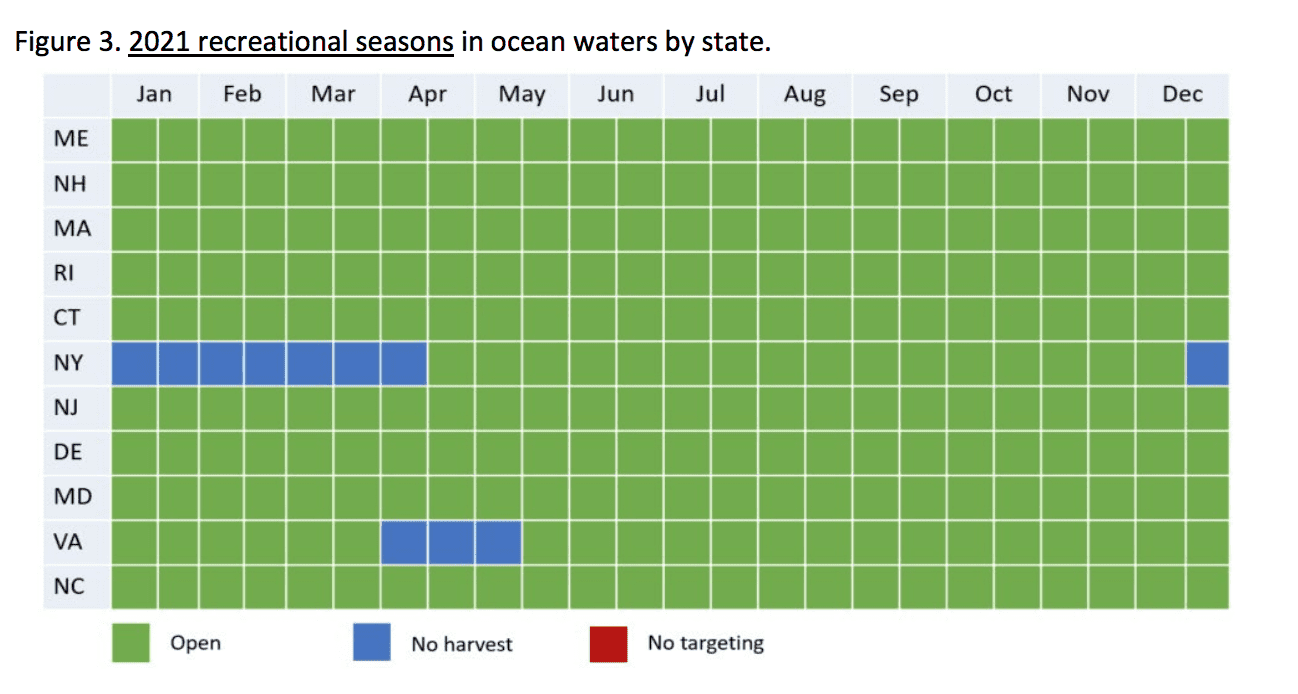
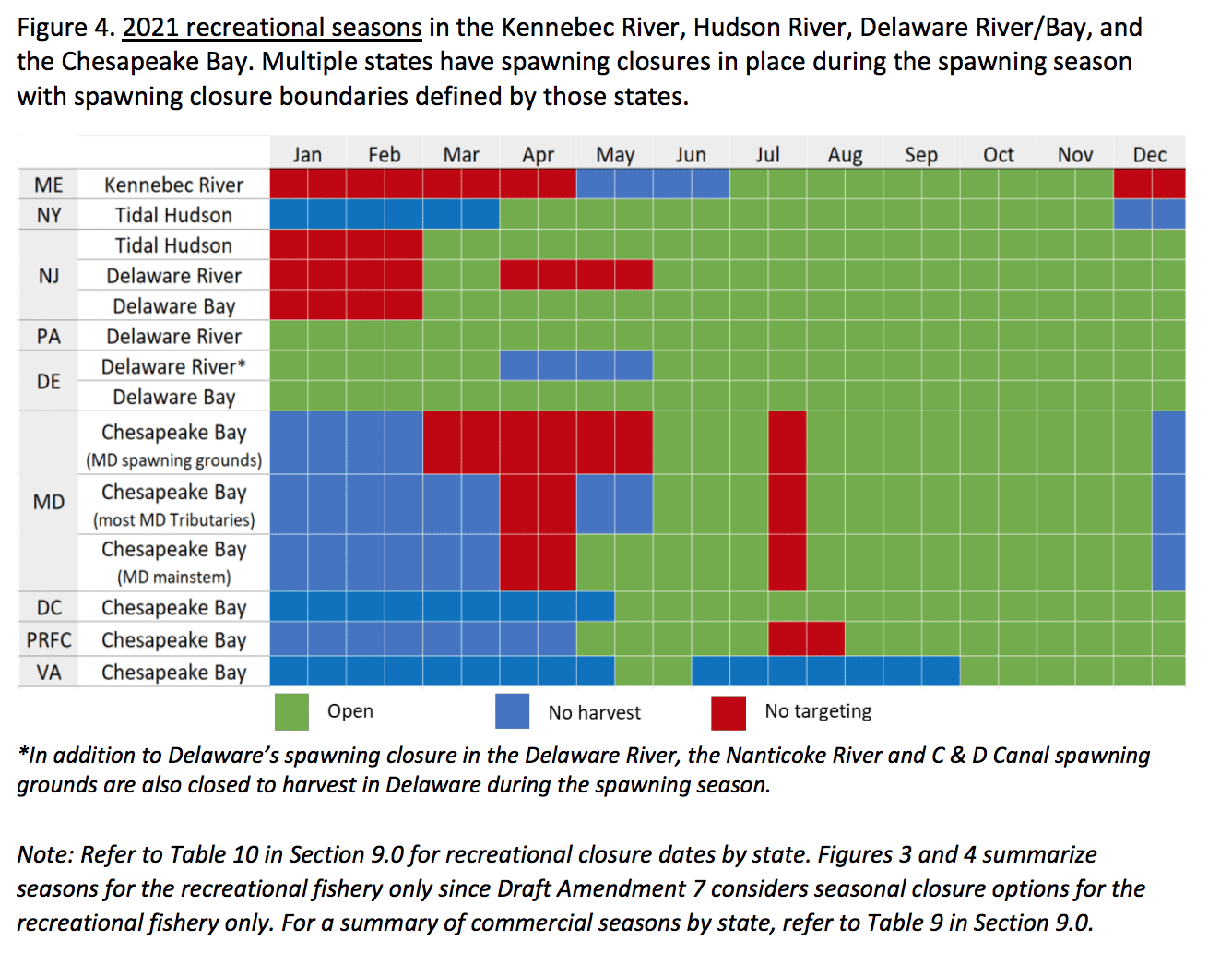
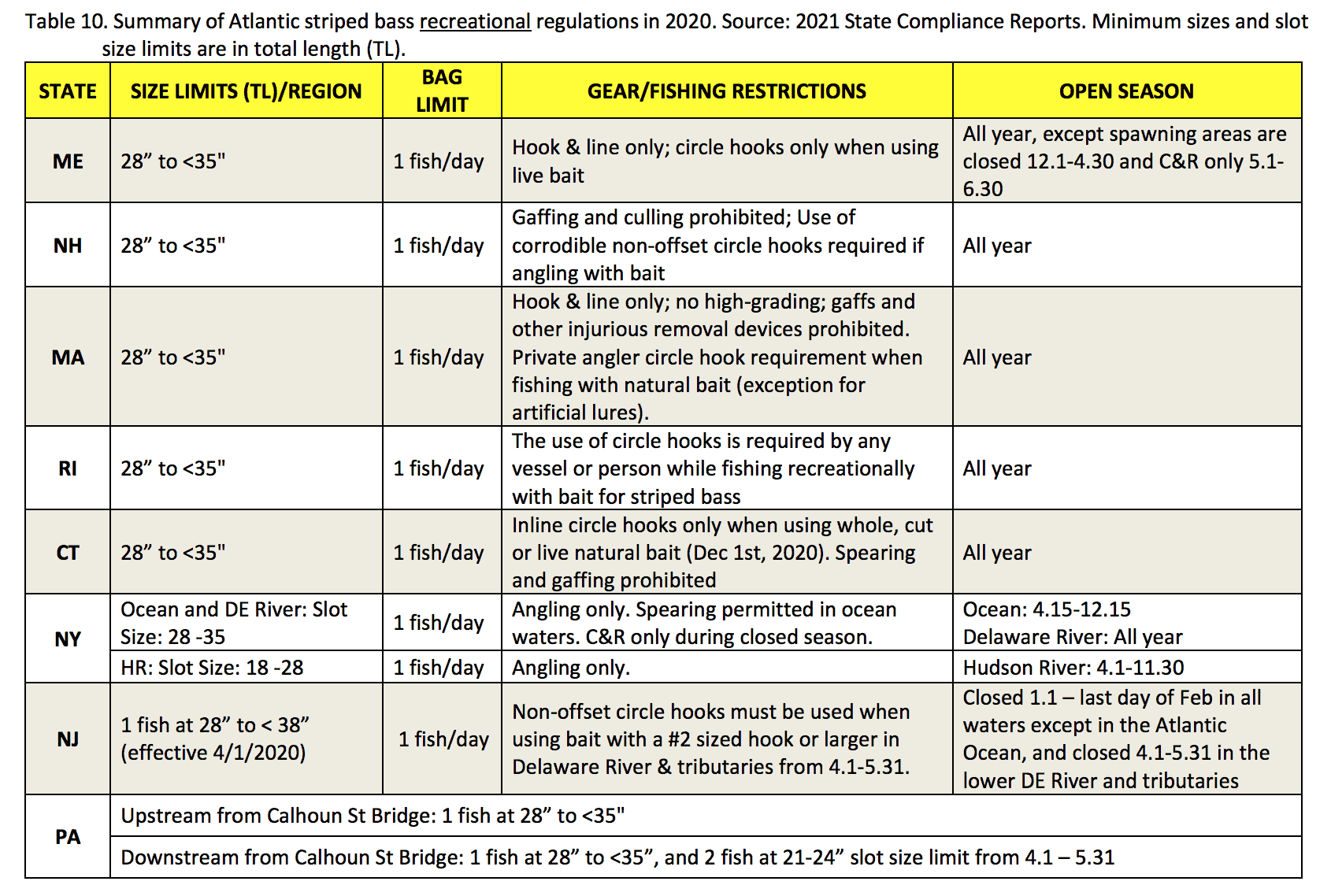
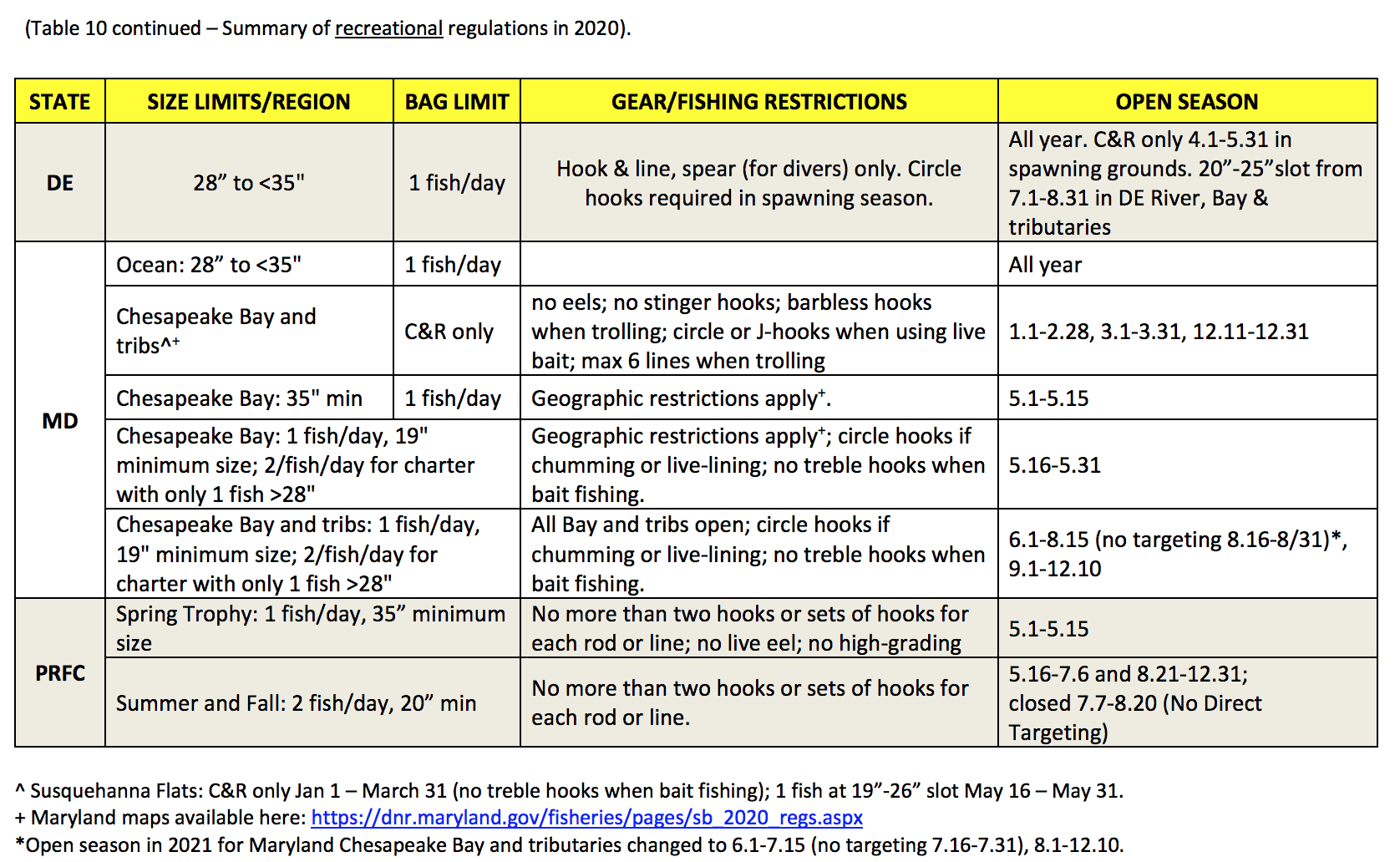
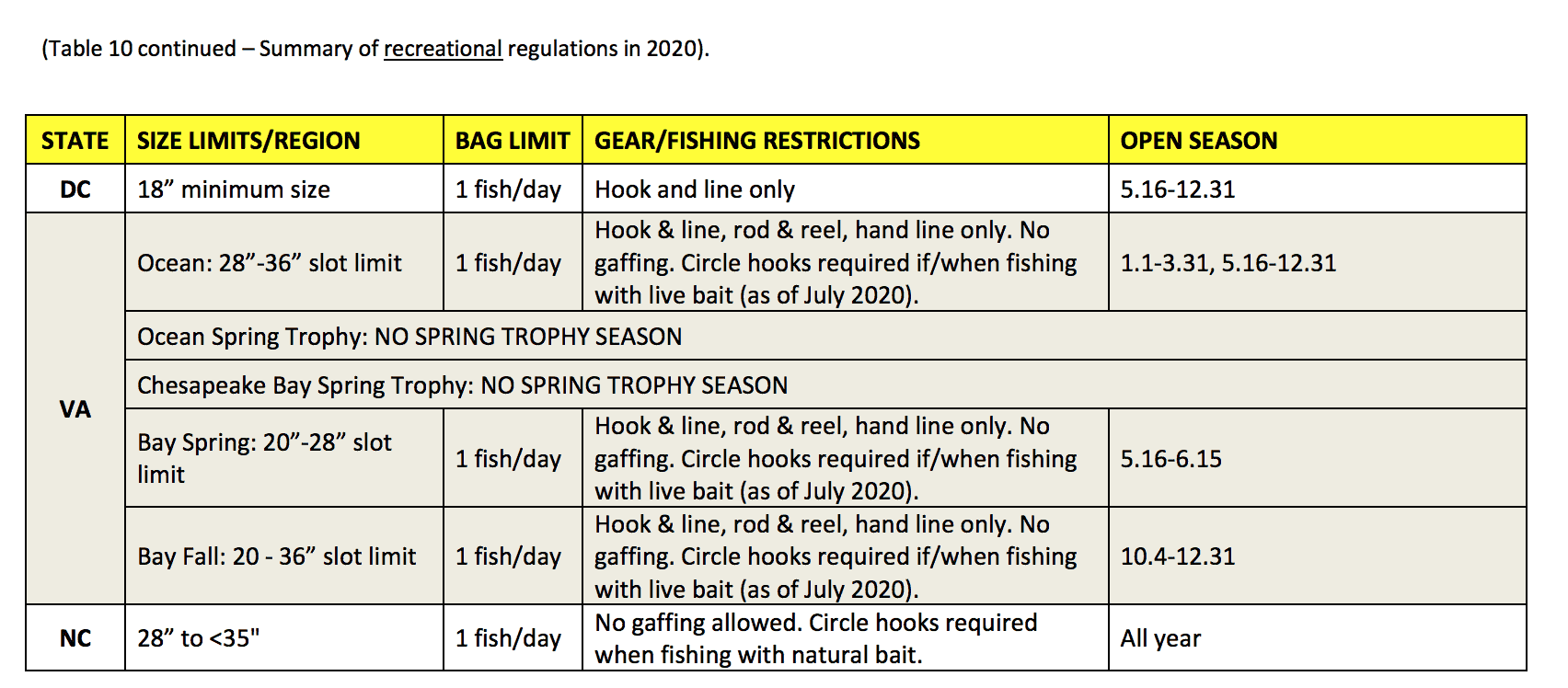
4.3 Commercial Fishery Management Issues
4.3.1 Size limits
CCA Comments: Specific management actions related to commercial fisheries are not under consideration in Amendment 7 at this time. The coastwide analysis of the total removals provided in the last benchmark assessment largely reset our understanding of the balance of total removals amongst sectors. Unfortunately, this has led to a perspective that only recreational mortality truly impacts the rebuilding of this stock.
This was driven by the MRIP recalibration that has caused conflict and instability in other shared fisheries, namely , Summer Flounder, Scup and Black Sea Bass in the Mid-Atlantic region.
Given this shift in recent focus, it is very important that the Board recognizes the composite or combined nature of overall fishing mortality(F) in the striped bass management plan across all sectors. One specific action could be to protect SSB above a specific size in all fisheries to maximize spawning potential through this current rebuilding plan or until recruitment increases to fulfill current or future fishery goals and biomass targets.
See Table 9 for current commercial harvest regulations. (Page 124 of the document & page 131 & 132 of 149)
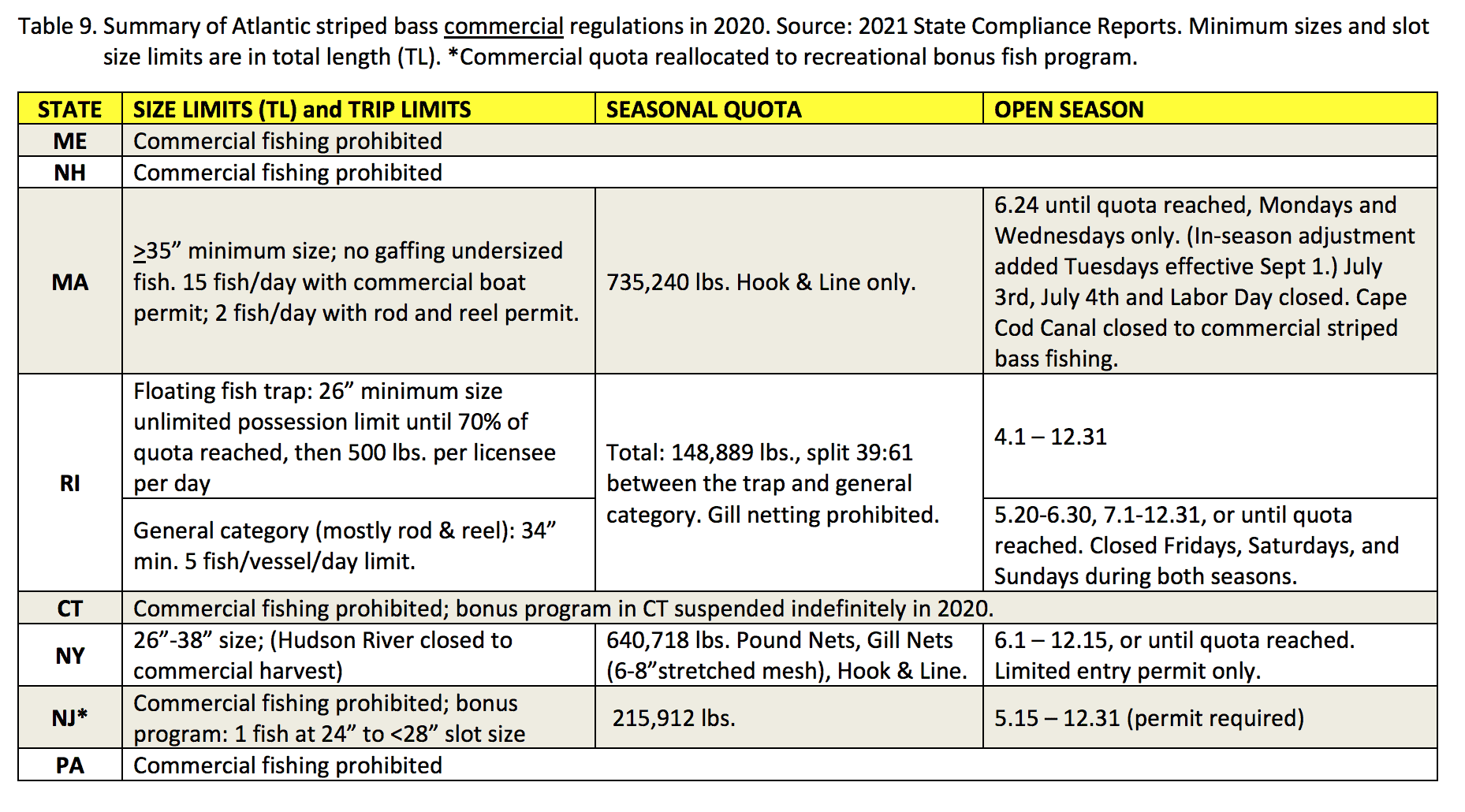
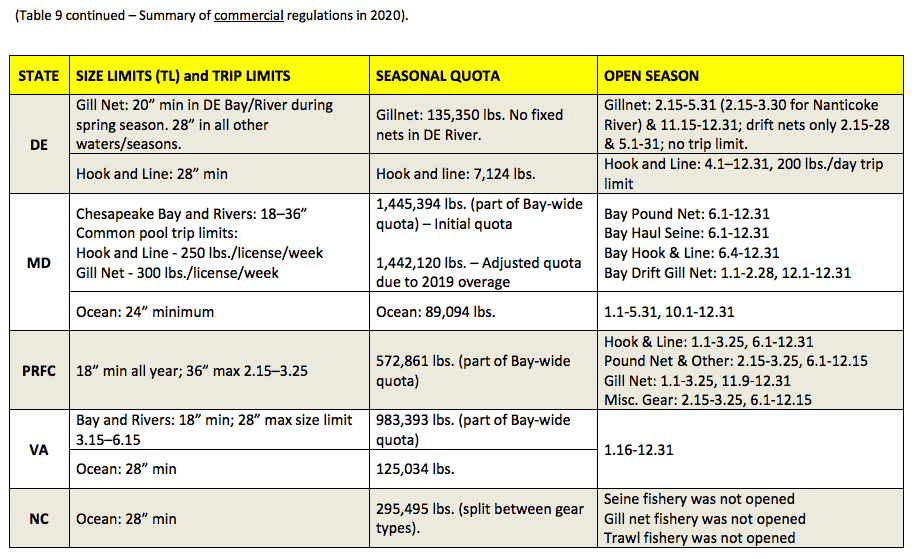
4.4 Rebuilding Plan
The first steps of rebuilding the striped bass stock were triggered when the 2018 benchmark stock assessment showed that the stock was overfished and that overfishing was occurring. Rebuilding means that the stock is returned to above the threshold and to the target within 10 years. This is accomplished by reducing fishing mortality (F) to the target or to another level, which will achieve a specific outcome ie: rebuilding more quickly or slowly.
Model projections provide the Board guidance on what F rate will achieve a specific increase in biomass over a time period. These projections are based on assumptions about recruitment, natural mortality and fishing mortality caused by harvest and discard mortality.
4.4.1 Recruitment Assumption for Rebuilding Calculation (pg. 67 of doc. pg. 75 of 149 of PDF)
Option A (status quo): Rebuild using Standard recruitment method
B: Rebuild using Low Recruitment Assumption – **CCA Preferred Option**
CCA Recommendations: Given the known and unknown impacts of prevailing spawning habitat value, environmental drivers on reproduction and changes in natural mortality throughout the Chesapeake Bay and its tributaries, the Board should task the Technical Committee with developing projections that include even lower assumptions about reproductive success and future recruitment into the striped bass stocks and fisheries. The impact of invasive species, forage availability, poor water quality, and climate change should be a high research priority that guides overall strategies for harvest and overall removals from all components of the striped bass fishery coastwide.
4.4.2 Rebuilding Plan Framework
Option A (status quo): Addendum process needed
Option B: Fast track, no public comment needed. – **CCA Preferred Option**
CCA Recommendations: Given the current status of the stock, the stock assessment update delay caused by the pandemic and concerning recruitment trends in the Chesapeake, Option B presents the best option available to the Board to control fishing mortality for the 2023 fishing season. While all states can enact more conservative measures through their regulatory process, it is imperative that the Board take proactive action to not only rebuild the stock within the current timeline, but also be ready to reduce fishing mortality in a meaningful way to avoid over exploitation of the current SSB and fish that have not yet recruited into the spawning stock.
4.6.2 Management Program Equivalency
Management program or conservation equivalency (CE) is an important tool to provide flexibility to states in managing diverse fisheries that may vary greatly from one region to another and throughout the year.
CCA Recommendations: While CE is a valuable tool for the state management of fisheries, the data and approval process used by the Board in recent years has proven to fall short of constraining fishing mortality. Using imprecise estimates of catch and effort from MRIP has proven to not provide the on-water results consistent with the sustainable management of striped bass resource. For these reasons, CE should be removed as an option for management at this time and the Board should focus on simple and consistent coastwide and Chesapeake Bay regulations to increase our certainty that rebuilding goals will be met.
Option A: (status quo): Board Discretion on CE Restrictions and Requirements
B: Restrict the Use of Conservation Equivalency Based on Stock Status
Sub-option B1- Restrictions: CE would not be approved when:
B1-a: Stock is at or below the biomass threshold **CCA Preferred Option**
B1-b: Stock is below the biomass target
B1-c: Fishing mortality is at or above fishing mortality threshold **CCA Preferred Option**
Option C: Precision Standards for MRIP Estimates Used in CE Proposals
C1: 50%
C2: 40%
C3: 30%- **CCA Preferred Option**
Option D: Conservation Equivalency Uncertainty Buffer for Non-Quota Managed Fisheries,
D1: 10% – **CCA Preferred Option**
D2: 25%
D3: 50%
Option E: Definition of Equivalency for CE Purposes with Non-Quota Fisheries
E1: % reduction/liberation at coastwide level- (SQ)
E2: % reduction/liberation at state Level
CCA Comments: CE uncertainty buffers are an important item for consideration to account for uncertainty in the outcomes of any future plans. The buffers offered in this action are subjective in nature, with no specific scientific analysis to specify penalties based on data shortcomings or precision challenges provided by MRIP. The Board could consider tasking the Technical Advisors with an objective analysis of precision or a lack there of as a guiding principle for buffers if and when future CE proposals are considered. This approach would provide states with an incentive to design specific efforts to increase accuracy in specific components of their fisheries to better define the impacts and increase management certainty that regulations will achieve the expected outcomes. Option E should be carefully considered for the striped bass fishery when the stocks return to acceptable levels, as this option is an important question that relates to state to state allocation and is best assessed when given a specific situation that the Board may face with a healthy stock. We are not there with striped bass now.
Ultimately, Option A and Sub-Options B1-a&c address the overarching issues with CE at this time for the striped bass fishery, largely making Option D a factor only if the Board continues the use of CE, which is in opposition to many stakeholders’ desires given the striped bass stock condition at this time.

